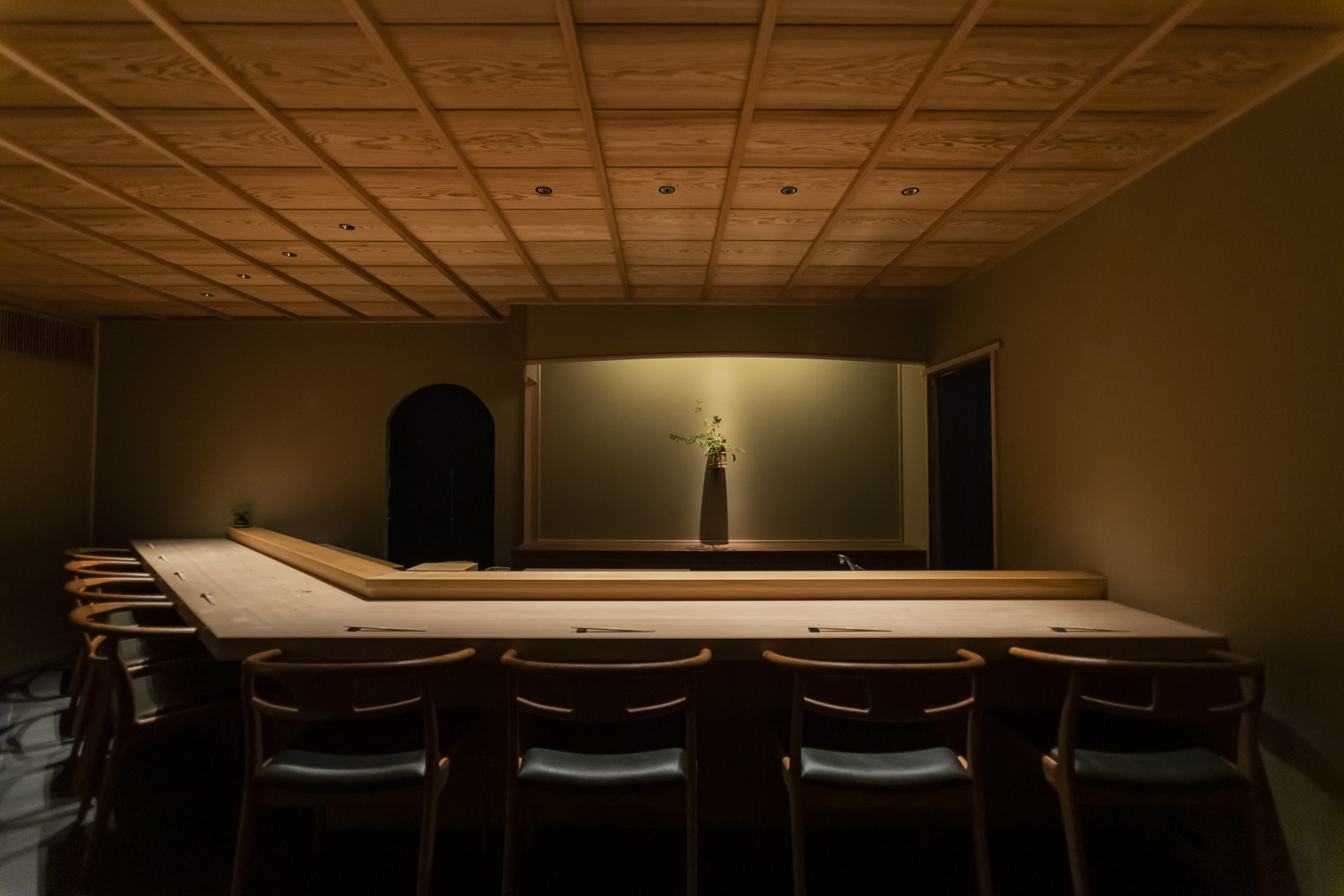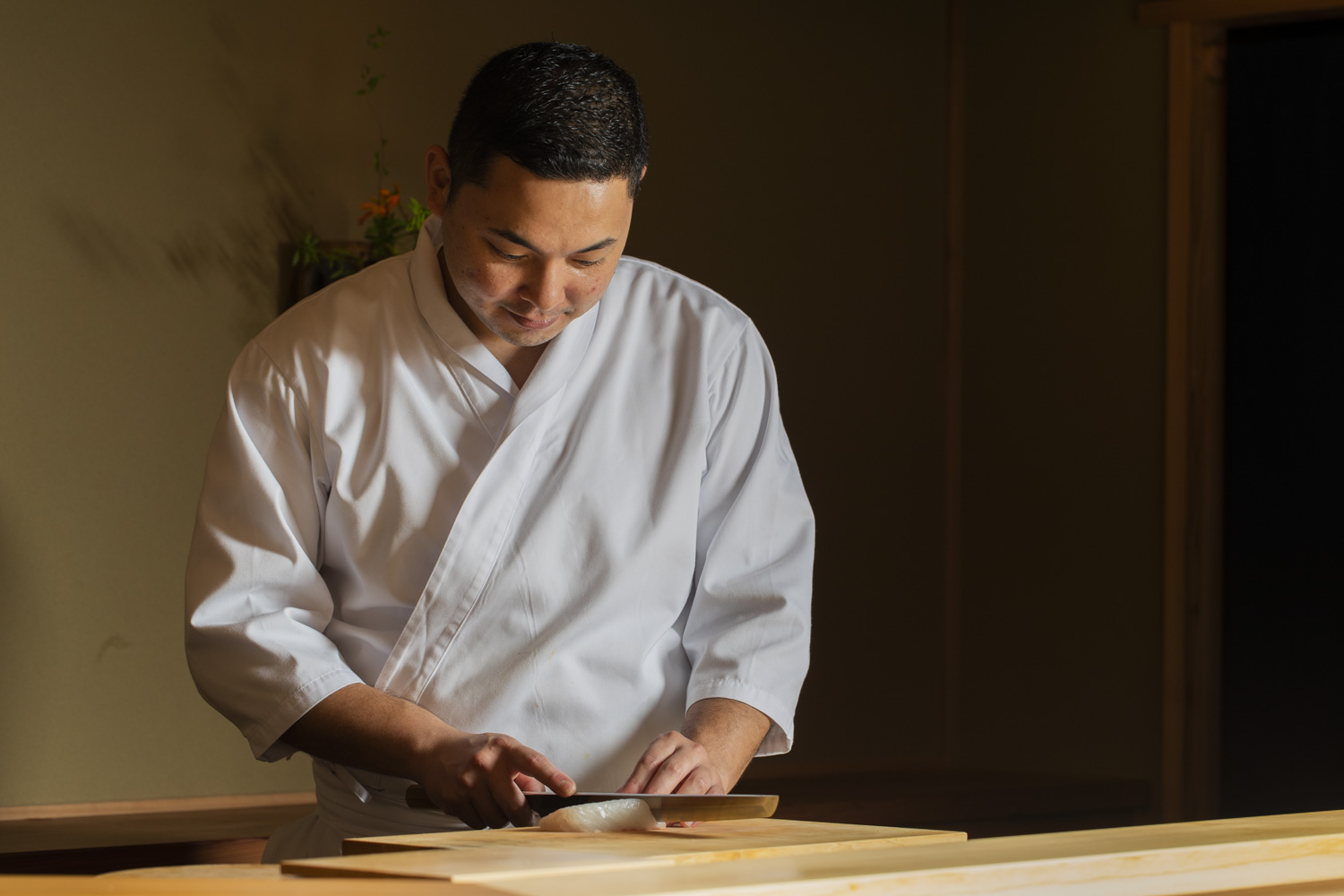
Fukuoka
Kotan
枯淡
Kotan epitomizes elegant simplicity in every sense. The modern yet very Japanese space intensifies your anticipation as this escape from the everyday begins. Slowly shifting your focus from the interior to the tableware and on to the delectable sushi, allow yourself to delight in the total Japanese dining experience.
Alight at the station in the wealthy Fukuoka neighborhood of Sakurazaka and stroll two minutes from the main shopping street to find a crisp white noren hanging gently before a lattice door. The absence of a signboard reflects the chef’s philosophy of stripping away layers of pomp and presentation in the pursuit of a pure focus on flavor.
Kotan opened its doors in November 2021 as the first independent foray by a chef who was born in Fukuoka and has returned after many years of training under some of the best sushi chefs in Japan. Already the most popular sushi restaurant in the region, it has Fukuoka gourmands abuzz, describing Chef Noguchi as the great hope for Fukuoka sushi craftsmen.
The eight-seat hinoki cypress counter is elevated like a stage above a concrete floor. The unique interior combines divergent styles and elements, as seen in the undressed concrete wall on the entrance side and the sukiya tea ceremony construction style in the serving area. The space is not at all intimidating, with a ceiling purposely lowered to give a cozy feel and lighting placing all the focus on the food.
CUISINE
Edomae mastery meets the blessings of Kyushu waters
The name Kotan derives from a Japanese tea ceremony concept that can be translated as ‘elegant simplicity’. It refers to something that despite its simple and light composition leaves you with a sense of refinement and deep flavor. The chef chose it because the concept fit so beautifully with his philosophy based on an honest consideration of each ingredient’s intrinsic flavors and avoidance of excessive treatment.
While a visit at lunchtime entails a selection of courses, dinner is omakase only – a course of twenty or so delicacies with around fourteen pieces of nigiri. The omakase starts with otsumami small plates like sashimi of seasonal, white-fleshed fish, octopus, and a warm bowl of simmered abalone, before a refreshing palate cleanser of mozuku seaweed. Next comes a moreish accompaniment to keep the sake flowing, then a grilled dish and a steamed dish. The parade of sumptuous nigiri begins with shimmering silver-skinned fish like shinko or kohada gizzard shad, moves on to shellfish and maguro, then meanders into varieties cured in kombu or vinegar followed by richer flavored morsels of shrimp and uni sea urchin. The beautifully composed course closes with anago conger eel in traditional Edomae fashion.
Chef Noguchi’s wish is to please guests with unwavering deliciousness every time, so while the structure remains unchanged, there may be small seasonal adjustments like switching the order of akami, chutoro and ootoro tuna. His creed is this: minimal intervention, no eccentricity, and cuisine stripped back to reveal ingredients in their purest form. Fish is rested a little for flavor but never aged, nor does he serve anything on a whim. For Noguchi, it is all about giving guests the deepest sense of enjoyment with familiar items.
The focus on innate flavors has yielded an obsession with the rice ovals that transport the toppings into diners’ mouths. For Noguchi, the rice must be a bundle of punctuated grains that gently falls apart in the mouth. Unlike his master Hashimoto, who uses an akazu red vinegar base, Noguchi’s rice is flavored primarily with rice vinegar and only a touch of akazu. His emphasis on rice vinegar comes from a deep understanding of the locale: Fukuoka is blessed with an abundance of white-fleshed fish. The acid is neither too strong nor too shy in its flavoring of the Aichi no Kaori rice cultivar. The cooked rice grains are large with noticeable contours, steamed just to al dente. He shapes the ovals while the rice is still quite warm to avoid the firm grains drying out.
One of the signature dishes at Kotan is nigiri of kombu-pressed kisu sillago whiting fish that is brought ashore at a fishing port right near the Fukuoka PayPay Dome – home to the city’s beloved baseball team. Served year-round, the fish is prepared according to traditional Edomae techniques to imbue it with deep kombu flavor. Local produce given Edomae treatment — this perfect bite weaves together the story of a Fukuoka local trained in Tokyo, now standing on his own to delight guests back in his hometown.
INGREDIENTS
Kyushu waters supply seventy percent of the seafood at Kotan, sourced every morning at local markets like Nagahama Fish Market in Hakata and another nicknamed ‘Hakata’s kitchen’, the Yanagibashi Rengo Market. Maguro and shellfish are shipped from Tokyo's Toyosu Market, the former from a long-established fishmonger who only supplies wild bluefin tuna caught in Japanese waters.
Local products also feature in the seasonings, with both the soy sauce and salt accompaniments coming from Noguchi's hometown of Itoshima. As seen in the additive-free soy sauce made from organic soybeans and wheat, and the mineral-rich seaweed salt, the focus is on quality raw materials and traditional techniques.
Unlike the food ingredients, many of the ten to fifteen sake varieties come from further afield — from Hokkaido in the north to Kagoshima in the south. Three or four types of both red and white French wines are also available. An additional five varieties of champagne, including half bottles, round out the wine menu, guaranteeing to please sake afficionados and wine lovers alike.


CHEF
Kazuki Noguchi
TABLEWARE and INTERIOR
The fastidiousness extends beyond food into tableware and space for Noguchi, who wants to elevate the entire dining experience. His serving dishes are all Japanese antiques from the Edo and Meiji periods, a collection begun under Hashimoto’s influence. Particularly fond of blue and white porcelain, one of Noguchi’s favorites is a set of deep cups for dipping soba noodles. They are early Imari ware, said to be Japan’s first porcelain. Another is a set of small plates from the mid to late Edo period made using a technique known as konnyaku inban, a type of transfer that results in soft, blurry designs. The sake cups, in contrast, are by modern potters. Many of them were made by a potter from nearby Karatsu with whom Noguchi senses a special connection.
The hinoki cypress counter smoothed by a Kyoto-trained artisan is absolutely stunning, and everywhere you look there are thoughtful, elegant features that are testament to the incredible, traditional techniques of Japanese craftsmen. The cedar ceiling has been scrubbed to reveal the growth rings in the timber, and the door leading to the kitchen was made with sawara cedar that instead of being shaved was formed into shingles by hand. The most labor-intensive component is the ceiling in the approach to the restroom – a patchwork of splints of timber from Kurobe cedar, a popular material in tearoom construction. It is impossible not to be drawn in by the handsome handiwork.
Course
- The price includes our booking fee of ¥8,000
- The price includes our booking fee of ¥8,000












